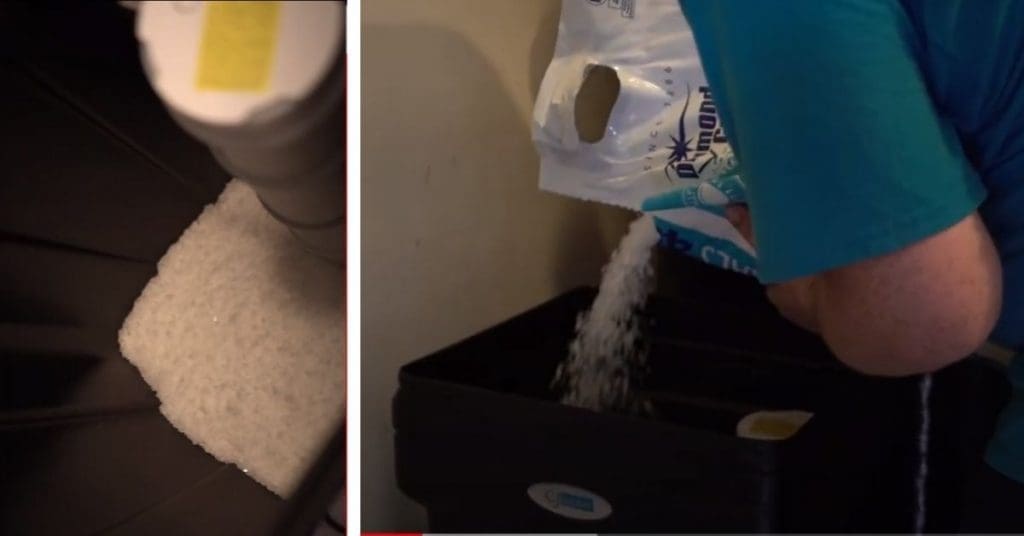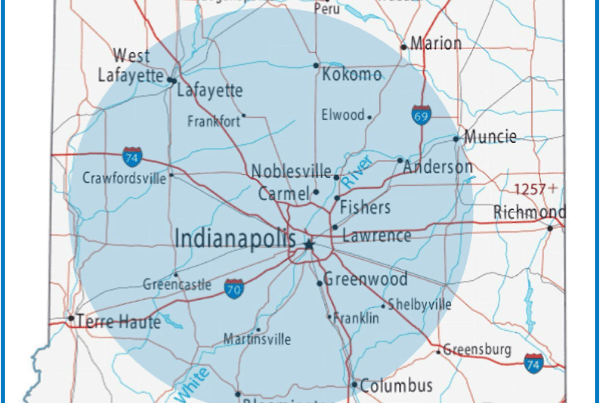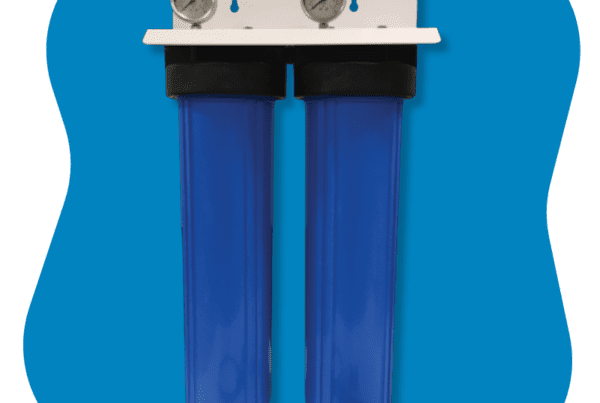Salt in the Brine Tank of Your Water Softener System
One of the most common questions among homeowners with a water softener system is how much salt should be in the brine tank. The brine tank is usually the plastic tank that sits next to your water softener.
The brine solution is a necessary part of the ion exchange process in a water softener because salt is what regenerates the ion resins of a softener. It is crucial for your softener’s components to have the proper amount of salt in the brine tank. In this post, we will discuss what that proper amount is, and how you can be sure to get the most out of your water softening equipment.
 How often should I have to add salt?
How often should I have to add salt?
Water softeners and conditioners work effectively with either sodium chloride (commonly referred to as salt) or potassium chloride (actually a type of salt also). It is important to understand that salt absorbs moisture and can clog or bridge and can become mushy. At this point the salt is useless. You should allow the salt to resolve down to, or at the water level before adding more. In other words—use what you put in before adding more. How often you’ll have to add more salt to the brine tank will depend on a few factors.
— Size of the brine tank
While a separate brine tank is ideal, some water softeners have the brine tank built into the softener. These built-in tanks are usually smaller and therefore require you to add salt more often.
— Water hardness in your area
Unfortunately, Central Indiana has notoriously hard water. Harder water means more salt is needed for the ion exchange process and regeneration. It’s part of the water treatment process to provide soft water to homes. Certified water specialists can test your water for hardness, as well as program your softener to do all the calculations for you.
— The needs of your family
The size of your family and how much water you use are directly correlated with how often your brine tank needs to be replenished with salt. A larger family will most likely consume more water which will cause your softener to regenerate more frequently, and thus more salt will need to be added more often.
 How much salt should I add?
How much salt should I add?
We recommend keeping your brine tank at least one-quarter full of salt at all times and no more than 4-6 inches from the top in order to maintain optimal performance. Also, make sure that the salt level always remains a few inches above the water level. Before you add new salt pellets to the brine tank, be sure to loosen up any encrusted salt that may be sticking to the edges of the tank and make sure to break up any large pieces of salt.
If the salt has formed one solid mass (known as bridging), manually break up the salt block by pouring hot water over it—making it easier to break up and remove.
How much salt should my water softener use?
As mentioned above, the usage will vary depending on your family’s needs and the hardness of your water. If your softener is sized and programmed correctly, you will probably use between 40-50 pounds of salt per month. Make sure you check your salt levels at least once every month.
There always seems to be water in my brine tank—is that ok?
There will usually be several gallons of water in the bottom of the brine tank but usually is never more than twelve inches high. We recommend that you check the salt level in your brine tank at least monthly. The more often your system regenerates, the more you’ll need to check and add salt to the tank.
Does it matter what kind of salt I use?
Water softeners and conditioners work effectively with either sodium chloride (commonly referred to as salt) or potassium chloride (actually a type of salt, also). Potassium chloride may be used in place of sodium chloride in the brine tank to regenerate the softening resin. Potassium chloride is 99.9% sodium-free and an alternative for those who are looking to reduce sodium intake.
Be aware that potassium chloride pellets are generally more expensive and not as easy to find as salt pellets. If switching from salt to potassium chloride pellets, it may be necessary to increase salt dosage program settings on the valve by 10% to ensure proper regeneration of the resin.
Some of the softening salt pellets sold at the supermarket or home improvement store contain a high level of water-insoluble matter or impurities. This insoluble matter can cause buildup in the reservoir or cause your softener to malfunction. If you notice buildup, the brine tank will need to be cleaned more often. So as you shop for softening salt, look for labeling on the salt pellet sack that indicates you’re getting the highest purity level.
Evaporated salt pellets have the highest purity rate of the aforementioned salts and are generally the most expensive. The higher the purity of your salt (we prefer 99.9% pure salt), the less water-insoluble matter, which means less chance of “bridging”, “mushing”, or insoluble buildup in the bottom of the tank that will need to be cleaned out later.
Solar salt pellets are most commonly sold in crystal or pellet form and are made through evaporating seawater. Solar salt is more soluble than rock salt, but may not work as well as evaporated salt when your water hardness level is very high. Many solar salt brands contain 99.6 pure salts.
Rock salt resembles small rocks or pebbles. Although this form of salt is more economical, we don’t recommend using it as it contains a high amount of calcium sulfate which means it won’t dissolve well in water and can cause maintenance headaches.
Do you need a water softener installation or service?
If you still have questions about water softening, salt usage, or the hardness level of your water, contact us for a Free Water Analysis. We will come to your home and provide an analysis of your city or rural water and answer any questions you may have. Your visit will take 30 – 45 minutes and will be scheduled at a time that’s right for you. Contact us today to schedule!




